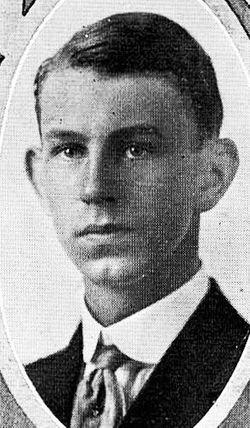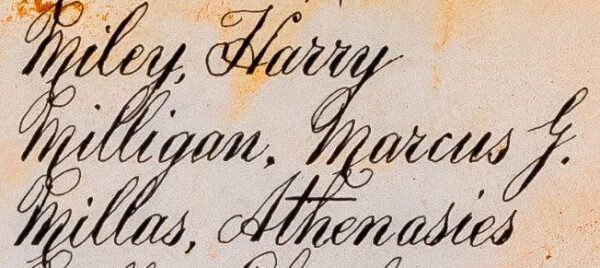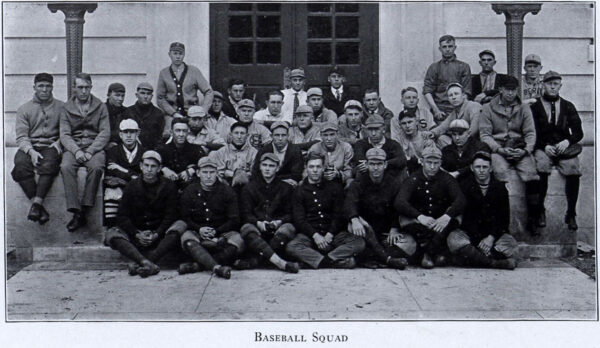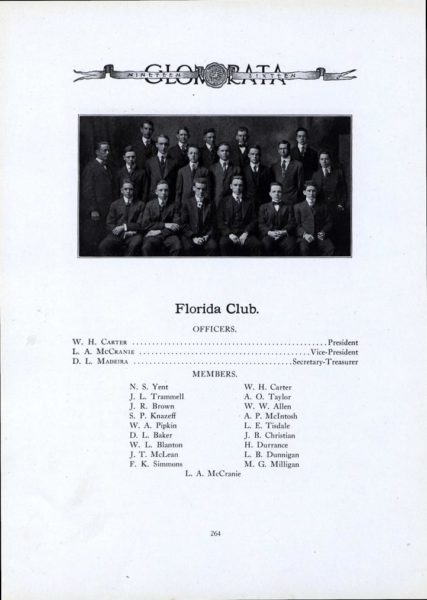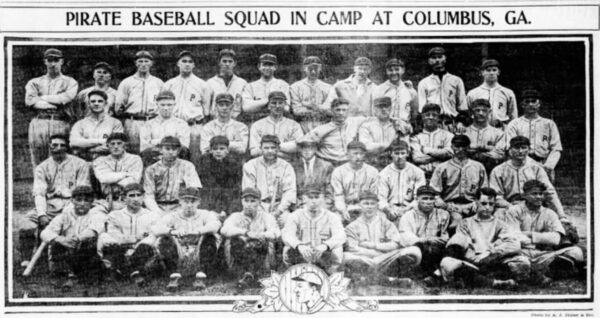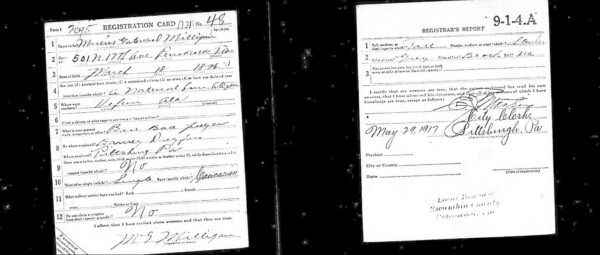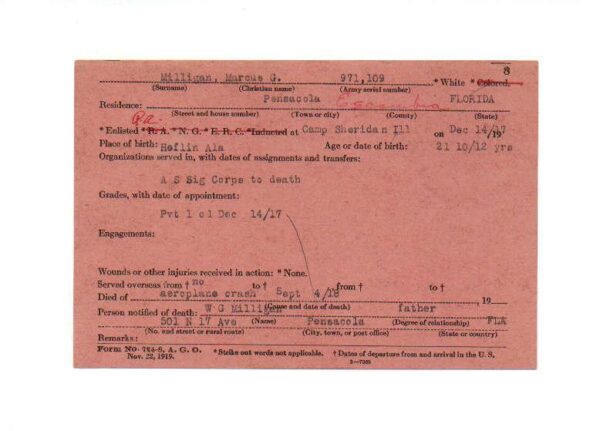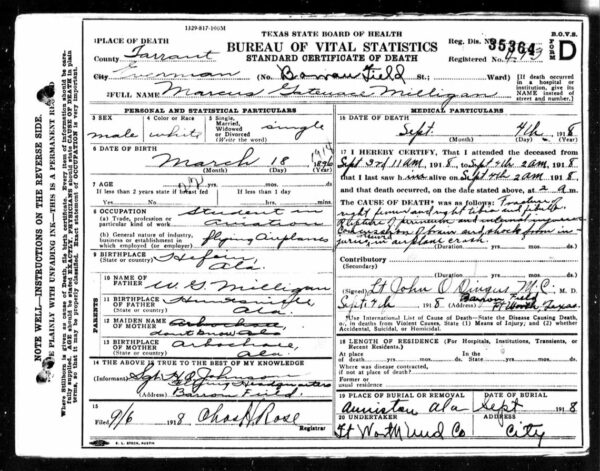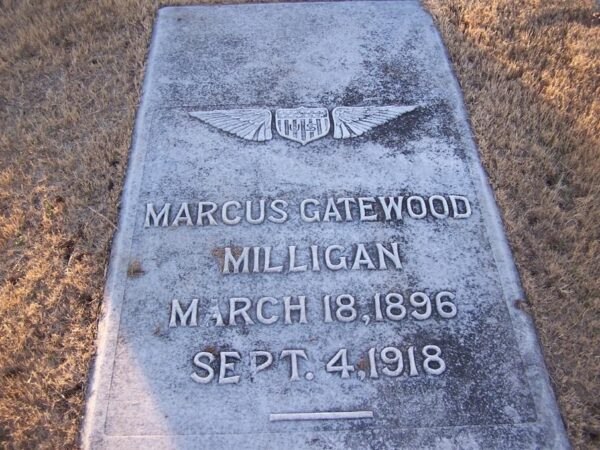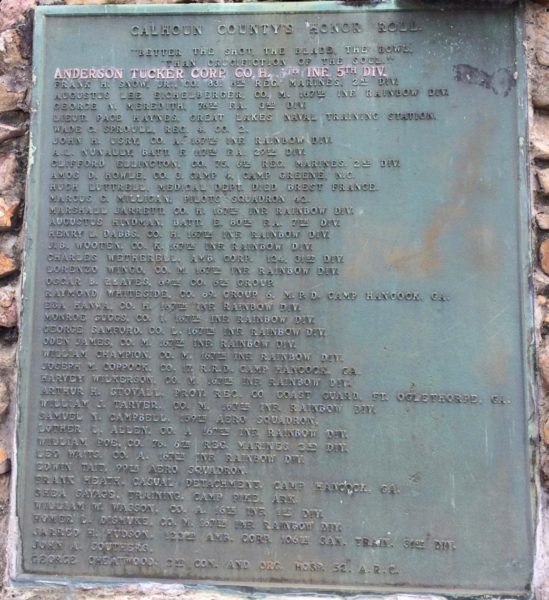Scroll 1 Page 2 #432
Milligan was the son of William Gatewood Milligan (1858-1936) and Mary Lou Pinson (1863-1943). Born March 18, 1896 in Heflin, Alabama, he had one sister, Nellie Mae Leyden (1889-1958). When Marcus (nicknamed “Mike”) was 16, he moved with his parents to Pensacola, Florida, where he attended high school. The 1916 city directory for Pensacola lists him as working in the family’s wholesale grocery business located at 501 North 17th Avenue. The 1916 yearbook for Alabama Polytechnic Institute (Auburn University, today), shows him as a Senior majoring in agriculture at the college, where he played both baseball and basketball. At 6 feet 2 ½ inches, he played center on the senior basketball team. But it was the former at which “Pickles” excelled, as explained in the Glomerata: “Pickles can play baseball all day [and] still not have enough.” He was among six pitchers on the varsity team. He was also a member of the Florida Club. Milligan, however, does not appear to have graduated from Auburn with his class, as he re-enrolled in the winter of 1917 to complete his studies.
The Auburn Varsity Baseball Team, 1916.
Florida Club (Milligan is standing 3rd row, 1st from left)
Meanwhile, Milligan had been invited to spring training in 1916 by Bernhard “Barney” Dreyfuss, owner of the Pittsburgh Pirates, and was signed by that club. To protect his amateur status at the time he played under the name “Orr” for the Portsmouth Truckers of the Class C Virginia League and was 8-0 in 16 appearances and batted .334. The National League club invited Milligan back for Spring training in Columbus, Georgia in 1917 and he remained with the club until the season began, when he was released to the Birmingham Barons of the Class A Southern Association, where he played home games at Rickwood Field under manager Carleton Molesworth. In 13 appearances, Milligan was 6-5. The highlight of his rookie season was a 6-0, two-hitter against Nashville on August 2, and he pitched well enough to earn a recall to the Pirates at the start of 1918. The following Spring, Milligan pitched a no-hitter versus the Atlanta Crackers, winners of the Southern League in 1917.
Milligan is standing back row, 5th from left. Pittsburgh Daily Post 4/1/1917.
During Spring training with the Pirates in March 1918, Milligan decided he would rather fight the Hun than play baseball. So, he volunteered for military service. In Jacksonville, Florida he said goodbye to his teammates and boarded a train for Pensacola to spend his 22nd birthday with his family before reporting to The School of Military Aeronautics at Ohio State University in Columbus.
When Milligan registered for the draft on May 28, 1917, in Pittsburgh, he gave his occupation as “Base Ball player” and Barney Dreyfuss as his employer.
The initial phase of flight training for Milligan consisted of an 8-week ground school, during which cadets learned the basics of flight, weather patterns, navigating by the stars, and military behavior. He then transferred to the U.S. Army Air Signal Corps primary flight school at Barron Field near Everman, Texas, about 12 miles south of Fort Worth. Flight school included another 8-week course, consisting of 4-10 hours of dual training (with an instructor), 24 hours solo, and a 16-hour cross-country flight. Before graduating from primary flight training, cadets were required to be able to perform sideslips, loops, a simulated uncontrolled fall, and other aerobatic maneuvers. The trainer used was a Curtis JN-4 Jenny. Although relatively easy to learn how to fly, the Jenny was considered heavy and relatively difficult to handle in landings and would frequently stall in recovery maneuvers. Pilots joked: “If you can fly a Jenny, you can fly anything!”
During World War I, approximately 23,000 U.S. volunteers entered flying cadet training. Of that number, roughly 11,000 flying cadets received their wings and were commissioned before entering another four weeks of advanced training stateside. Some 300 pilots were trained at Barron Field alone.
Cadet Milligan undoubtedly wanted his wings but things did not go as planned. In his sixth week of training, on the morning of September 3, 1918, he was in an accuracy flight when his engine stalled, causing the biplane to spin out of control and crash into the ground two miles south of Barron Field. His flight instructor, Lieutenant Sidney C. Greene of Calhoun, Georgia, was killed and Milligan was seriously injured. A broken right femur, tibia, and fibula, and a ruptured perineum, were worrisome enough, though manageable. But a brain contusion and internal injuries proved fatal. He died at 2 am at the base hospital the following morning.
“Milligan did not get to face the Hun,” eulogized the Anniston Star on September 7, 1918, “but he is a hero nevertheless; for he sacrificed a brilliant career to enter the army, he underwent great hardships to train himself for service abroad, and he died for you and me just the same as if he had been to France . . . He was . .. an American, and he died for America. It is fitting, therefore, that we pay him tribute and lend our sympathy to those of his loved ones who are bereaved.” On Sunday, September 8, Marcus Gatewood Milligan was buried in Edgemont Cemetery in Anniston, Alabama, where he finally earned his wings.
Less than a month earlier, Cadet Milligan pitched for the Barron Field baseball team against the Auto Repair Depot of Dallas in the Air Service League in the Dallas-Fort Worth area. “It was his effective hurling and hitting” that gave the Everman team a 4-3 victory, observed the Fort Worth Star-Telegram of August 18, 1918. He struck out six batters and drove in two runs. Milligan loved playing baseball.
Ten others among Florida’s Fallen died from an aeroplane accident during World War I. They include Lindley Haines (Diggie) DeGarmo of Coconut Grove, who crashed in London, England, Veryl Leo Nichols of Winter Haven, who died at Carlstrom Field in Arcadia, Florida, and Ensign Benjamin Lee, II of Jacksonville, whose hydroplane went down near Naval Air Station Killingholme in England.
Marcus Milligan’s Florida Service Card.
Texas Death Certificate for Marcus Gatewood Milligan.
The grave of Marcus Gatewood Milligan, with wings.
Milligan is memorialized on the Calhoun County, Alabama monument plaque erected by the William Forney Chapter of the UDC in 1921.
Milligan’s name is the 12th one listed on this tablet.

